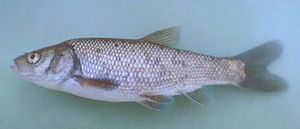Owens tui chub facts for kids
Quick facts for kids Owens tui chub |
|
|---|---|
 |
|
| Conservation status | |
| Scientific classification |
|
| Kingdom: | Animalia |
| Phylum: | Chordata |
| Class: | Actinopterygii |
| Order: | Cypriniformes |
| Family: | Leuciscidae |
| Genus: | Siphateles |
| Species: | |
| Subspecies: |
S. b. snyderi
|
| Trinomial name | |
| Siphateles bicolor snyderi (R. R. Miller, 1973)
|
|
| Synonyms | |
|
Gila bicolor snyderi |
|
The Owens tui chub (Siphateles bicolor snyderi) is a unique type of fish. It was first described in 1973. This fish lives only in the Owens River area of Eastern California, United States. This means it is endemic to that region.
The Owens tui chub is a subspecies of the larger tui chub family. It looks a bit different from its closest relative, the Lahontan tui chub. For example, its scales and certain bones in its throat are different. It also has a different number of gill rakers and lateral line scales.
This fish can be bronze or dark green on its back and sides. Its belly is usually silver or white. An adult Owens tui chub can grow up to 30 centimetres (12 in) long. Scientists believe these fish came from Lahontan Basin tui chubs. They likely moved into the Owens Basin a very long time ago, during the Pleistocene Epoch (Ice Age).
Where the Owens Tui Chub Lives
Owens tui chubs used to be very common. They lived in almost all the wet areas near the Owens River. This includes parts of Inyo and Mono counties. Other fish like Owens suckers and Owens pupfish also live in these same areas.
Today, some Owens tui chubs have mixed with Lahontan tui chubs. This happened because of changes in their habitats. However, you can still find pure Owens tui chubs in certain places. These are usually waters that are cut off from the main Owens River.
Some of these special places include Sotcher Lake near Reds Meadow. They also live in springs near the Hot Creek Fish Hatchery in Mammoth Lakes, California. You can also find them in special ponds at the White Mountain Research Center and Mule Spring in Inyo County.
What the Owens Tui Chub Eats
Owens tui chubs like to live in calm, deep water areas. They prefer places with lots of water plants. These plants give them good places to hide. They also provide food for the insects that the chubs eat.
These fish mainly eat by picking food off submerged plants. Their diet changes depending on the time of year. In spring, they mostly eat tiny insect larvae called chironomids and algae. In summer, chironomid larvae are still their main food. In the fall, they eat small insects called hydroptilid caddisflies. During winter, they go back to eating mostly chironomid larvae.
Life Cycle and Reproduction
Owens tui chubs start to lay eggs from late winter to early summer. This happens in spring habitats. The length of the day likely helps trigger their spawning.
In rivers and lakes where water temperatures change with the seasons, they spawn in spring and early summer. Here, warming water temperatures are what trigger the spawning. A female Owens tui chub can lay more than 10,000 eggs! These fish can become old enough to reproduce at about 2 years old. Some tui chubs can live for more than 30 years.



